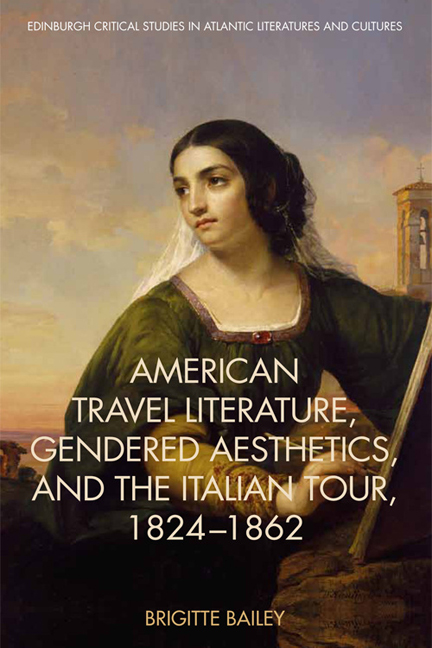Book contents
- Frontmatter
- Contents
- Illustrations
- Acknowledgments
- Introduction
- 1 Irving's Landscapes: Aesthetics, Visual Work, and the Tourist's Estate
- 2 The Protected Witness: Cooper, Cole, and the Male Tourist's Gaze
- 3 Gazing Women, Unstable Prospects: Sedgwick and Kirkland in the 1840s
- 4 Fuller and Revolutionary Rome: Republican and Urban Imaginaries
- 5 National Spaces, Catholic Icons, and Protestant Bodies: Instructing the Republican Subject in Hawthorne and Stowe
- Conclusion: Gender and Genre
- Notes
- Bibliography
- Index
2 - The Protected Witness: Cooper, Cole, and the Male Tourist's Gaze
Published online by Cambridge University Press: 10 May 2023
- Frontmatter
- Contents
- Illustrations
- Acknowledgments
- Introduction
- 1 Irving's Landscapes: Aesthetics, Visual Work, and the Tourist's Estate
- 2 The Protected Witness: Cooper, Cole, and the Male Tourist's Gaze
- 3 Gazing Women, Unstable Prospects: Sedgwick and Kirkland in the 1840s
- 4 Fuller and Revolutionary Rome: Republican and Urban Imaginaries
- 5 National Spaces, Catholic Icons, and Protestant Bodies: Instructing the Republican Subject in Hawthorne and Stowe
- Conclusion: Gender and Genre
- Notes
- Bibliography
- Index
Summary
I thought of the singular position of the American traveller in Italy. It is like that of a being of another planet who invisibly visits the earth. He is a protected witness.
Ralph Waldo EmersonThe beginning of the sustained influx of American tourists into Italy – in the 1820s and 1830s – coincided with the peak of what C. P. Brand calls the “Italianate fashion” in England. As travel became possible again after the Napoleonic Wars, this English vogue resulted in a wave of visual and literary representations of Italy and things Italian. The widely diffused nature of the fashion, which spread through elite and popular culture, suggests that the encounter with Italy was a vehicle for the ongoing construction of a national subjectivity. “Italy” represented aspects of experience defined in opposition to “English traits”; it therefore helped to define the traits themselves. For middle-and upper-class Americans, at work on situating a national identity with respect to the English model, tourism became a way of furthering a similar cultural project. U.S. tourists entered into the English complex of assumptions behind the Italian journey and replicated the English sense of the tourist as a privileged observer who could comprehend non-English traits without being determined by them. In the journal of his 1833 tour, Ralph Waldo Emerson defined the American perspective on Italy in terms of this model of privileged spectatorship; while surveying the Italian landscape, the alien tourist – the “being of another planet” – remained invulnerable or “invisibl[e]” to its counter gaze. In establishing their “singular position” with respect to Italy, these “protected witness[es]” were conscious of engaging English habits of perception and of their own mixed feelings about identifying with these habits. But while they often resisted British assumptions that England was normative, American travelers easily adopted the view of Italy as a foil and set up a similar opposition between Italy and the U.S.
In this period Anglo-American tourists approached the difference that Italy represented quite consistently through the terms and ideology of gender; they constructed a feminine Italy as a counterpoint to the normative and masculine world identified with Britain or the U.S. Their depictions of this encounter drew on an analogous cultural opposition of the period: that between word and image, linguistic and visual forms of expression.
- Type
- Chapter
- Information
- Publisher: Edinburgh University PressPrint publication year: 2018



